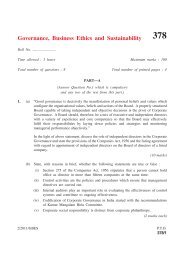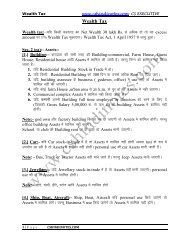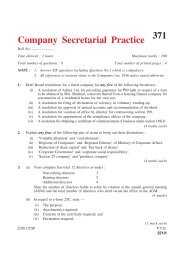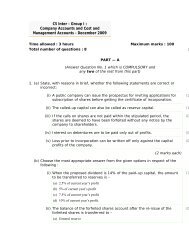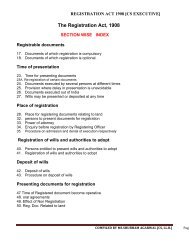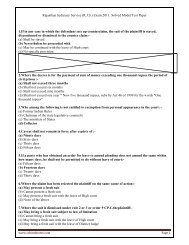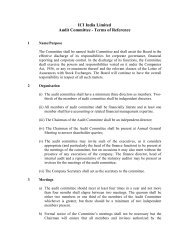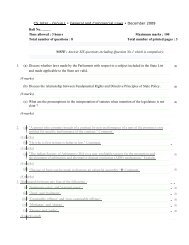SOLVED PAPER GCL JUNE 2011 - CS NOTES
SOLVED PAPER GCL JUNE 2011 - CS NOTES
SOLVED PAPER GCL JUNE 2011 - CS NOTES
You also want an ePaper? Increase the reach of your titles
YUMPU automatically turns print PDFs into web optimized ePapers that Google loves.
made by revenue authorities. (4 marks)<br />
Ans. As per the provisions of sections 49, 50, 52, 53 and 54, Stamp Duty can be refunded under the<br />
following circumstances:<br />
1. Spoiled Stamps;<br />
2. Misused Stamps;<br />
3. Stamps used in excess of the value required; and<br />
4. Stamps not required for use.<br />
The stamps purchased and not used for intended purpose are entitled for refund after deduction of<br />
certain charges, if lodged for refund within six months from the date of purchase<br />
<strong>2011</strong> ‐ June [3] (b) State the documents whose registration is optional under the Registration Act,<br />
1908. (4 marks)<br />
Ans. Section 18 of the Registration Act, 1908 provides for those documents whose registration is<br />
optional. These are as under –<br />
Instruments that create, extinguish or alter any right or interest in immovable property exceeding<br />
rupees one hundred in value.<br />
Instruments that recognize the receipt of any recompense for the above.<br />
Instruments that create, extinguish or alter any right or interest in movable property.<br />
Leases for which registration is exempted and the period of which is less than a year.<br />
Wills<br />
Instruments create, extinguish or alter any right or interest in immovable property for less than<br />
rupees hundred.<br />
<strong>2011</strong> ‐ June [3] (c) Discuss the rule of harmonious construction in the interpretation of statutes. (8<br />
marks)<br />
Ans. Rule of Harmonious Construction ‐ Where two provisions of the same enactment cannot be<br />
reconciled with each other they should be so interpreted that, if possible, effect may be given to<br />
both. This is the rule of Harmonious Construction. It helps in maintaining a link between the parts of a<br />
statute or between parts within a particular section when there is any discrepancy between them. By<br />
doing so, it ensures that no part is rendered redundant. The meaning is so construed that both the<br />
parts play a role in it.<br />
This rule of interpretation means that any section or part of a statute should be read with reference<br />
to the entire act, i.e. the meaning should be construed in entirety, not singularly. If while<br />
constructing the meaning of a section, it conflicts with the meaning given in another, in all<br />
probability there is an error in interpretation. Hence if two sections in the same statute seem to give<br />
different meanings or lead to opposite directions, the interpretation should be such as can<br />
accommodate both meanings.<br />
When two statutes are complementary to each other. One statute cannot be allowed to overrule the<br />
other. Instead one statute should be interpreted in such a way to compromise with the other<br />
statute. This is called Harmonious construction of Statutes.<br />
<strong>2011</strong> ‐ June [4] (a) The law of limitation bars the remedy in a court of law when the period of<br />
limitation has expired. However, there are certain exclusions in the computation of the period of<br />
limitation. Explain. (4 marks)<br />
Ans. Extension of limitation period and the Doctrine of Sufficient<br />
Cause<br />
Extension of limitation period is covered under Section 5 of the Limitation Act, 1963, which<br />
covers the Doctrine of Sufficient Cause. It provides for the period of limitation being extended in<br />
case the plaintiff was hindered by a cause serious enough to have prevented him from initiating<br />
proceedings. Calculation of Limitation Period<br />
Sections 12 to 19 and Section 24, which are contained in Part III of the Limitation Act, 1963, titled<br />
“Computation of Period of Limitation”, provide the details for this. They are as under –


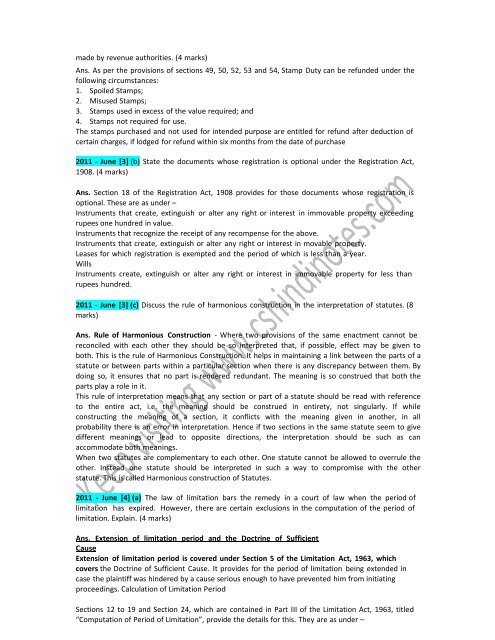
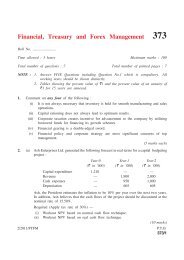
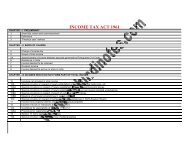
![vf/kfu;e dk vFkZ 'fu.kZ;' [ Interpretation of Statues ] Statue ... - cs notes](https://img.yumpu.com/38855798/1/190x245/vf-kfue-dk-vfkz-fukz-interpretation-of-statues-statue-cs-notes.jpg?quality=85)
